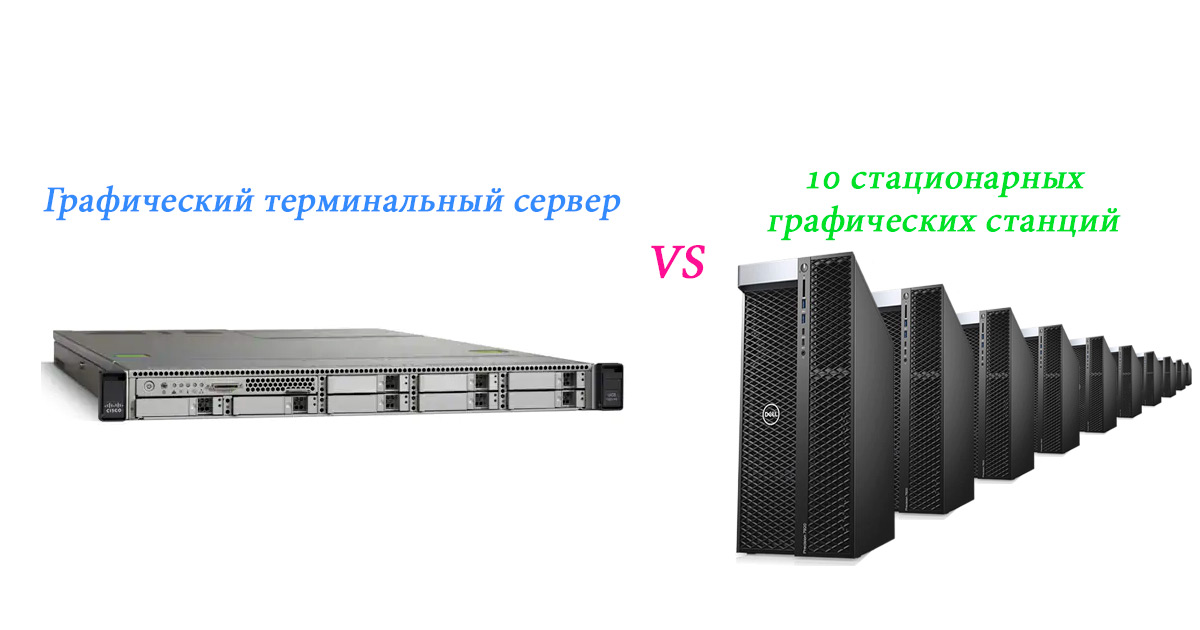
Almost every company now necessarily has a department or group working in CAD / CAM
or heavy design programs. This group of users has serious requirements for hardware: a lot of memory - 64GB or more, a professional graphics card, fast ssd, and to be reliable. Often, companies buy some users of such departments several powerful PCs (or graphics stations) and others less powerful, depending on the needs and financial capabilities of the company. Often this is the standard approach for solving such problems, and it works fine. But during a pandemic and remote work, and in general, such an approach is suboptimal, very redundant and extremely inconvenient in administration, management and other aspects. Why is this so, and which solution will ideally satisfy the needs for graphic stations of many companies? You are welcome under the cat, which describes how to build a working and inexpensive solution to
In December last year, one company opened a new office for a small KB and was tasked with organizing the entire computer infrastructure for them, given that the company already has laptops for users and a couple of servers. The laptops were already a couple of years old and they were mostly game configurations with 8-16GB of RAM, and mostly could not cope with the load from CAD / CAM applications. Users must be mobile, as they often need to work outside the office. In the office, each laptop is additionally purchased with a monitor (this is how they work with graphics). With such input data, the only optimal but risky solution for me is to implement a powerful terminal server with a powerful professional video card and nvme ssd disk.
Advantages of a graphical terminal server and RDP
- 35-100% . 5-20 .
- , /CAM 5000$, 10 000$. RDP , RDP , RDP . , RDP : RDP — , . , , .
- Also, a big plus is support for the same configuration and specific settings, components and templates, which is often difficult to implement for all PC users. Management, administration and software update also "without a hitch"
In general, there are many pluses - we will see how in fact our almost perfect solution will show.
We assemble a server based on the CISCO UCS-C220 M3 v2
Initially, it was planned to buy a newer and powerful server with 256GB DDR3 ecc memory and 10GB ethernet, but they said that they needed to save a little and fit into the budget for a terminal server of $ 1600. Well, okay - the client is always
bu CISCO UCS-C220 M3 v2 (2 X SIX CORE 2.10GHZ E5-2620 v2) \ 128GB DDR3 ecc - 625 $
3.5 "3TB sas 7200 from the USA іd - 2x65 $ = $ 130
SSD M.2 2280 970 PRO, PCI-E 3.0 (x4) 512GB Samsung - $ 200
QUADRO P2200 5120MB video card - $ 470
Ewell PCI-E 3.0 to M.2 SSD (EW239) adapter -10 $
Total for the server = $ 1435
It was planned to take ssd 1TB and 10GB ethernet adapter - $ 40, but it turned out that there was no UPS for their 2 servers, and I had to shrink a little and buy a UPS PowerWalker VI 2200 RLE -350 $.
Why a server and not a powerful PC? Justification of the selected configuration.
Many short-sighted admins (many times already encountered) - for some reason they buy a powerful (often a gaming PC), put 2-4 disks there, create RAID 1, proudly call it a server and put it in the corner of the office. The whole set is natural - a "hodgepodge" of dubious quality. Therefore, I will write in detail why such a configuration was selected for such a budget.
- Reliability!!! - all server components are designed and tested to work for more than 5-10 years. And game mothers work 3-5 years from strength and even the percentage of failure during the warranty period for some exceeds 5%. And our server is from the super-reliable CISCO brand, so no special problems are expected and their probability is an order of magnitude lower than a stationary PC
- ECC — , ECC , , 128 — . , , , ( ),
- — , ( E5-2620 Xeon E5 2690 v2) —
- U1 — ! , ( 1 ) ! (3-6 ) .
- : — ! !
- 128 — 8-10 , 5-6 — 2 30-40=70 4 3-15=36, + 10 116 10% ( . 256
- QUADRO P2200 5120MB —
0,3 1,5, 5 — . , , i5/64/Quadro P620 2, 3-4 - Samsung SSD M.2 2280 970 PRO, PCI-E 3.0 (x4) 512GB Samsung - for simultaneous operation of
8-10 users, NVMe speeds and Samsung ssd reliability are needed. By functionality, this disk will be used for OS and applications - 23TB sas - we combine in RAID 1 and use it for large or rarely used local user data, as well as for system backup and critical local data from the nvme disk
The config is approved and purchased, and the moment of truth is coming soon!
Build, configure, install and troubleshoot.
From the very beginning, I was not sure that this was a 100% working solution, because at any stage, from assembly to installation, launch and correct operation of applications, it was possible to get stuck without the ability to continue, so I agreed on the server during a couple of days can be returned and the other components can be used in an alternative solution.
1 far-fetched problem - professional, full-format video card! + a couple of mm, but what if it does not fit? 75w - what if the pci plug won't pull? And how to make a normal heat sink for these 75W? But I got in, started up, the heat sink is normal (especially if the server coolers are turned on at a speed higher than average. True, when I put it on, to be sure that nothing would close something in the server, I bent it by 1mm (I don't remember what), but for better heat dissipation from the cover the server then, after the final adjustment, tore off the instruction film, which was on the entire cover and which could impair the heat dissipation through the cover.
2nd test - the NVMe disk through the adapter might not be visible or the system will not be delivered there, and if it is, it will not boot. Oddly enough, Windows delivered to the NVMe disk, but could not boot from it, which is logical since the BIOS (even the updated one) did not want to recognize the NVMe for loading in any way. I didn’t want to crutches, but I had to - our favorite Habr came to the rescue and a post about downloading from an nvme disk on legacy systems downloaded the Boot Disk Utility (BDUtility.exe), created a USB flash drive with CloverBootManager according to the instructions from the post, installed the USB flash drive in the BIOS first to boot and now we load the bootloader from the USB flash drive, Clover successfully saw our NVMe disk and booted automatically from it in a couple of seconds! It was possible to play around with installing clover on our raid 3TB disk, but it was already Saturday evening, and there was still work to be done for a day, because until Monday it was necessary to either give the server or leave it. I left the bootable USB flash drive inside the server, there was just an extra usb.
3rd is almost a threat of failure. I installed Windows 2019 standart + RD services, installed the main application, for which everything was started, and everything works wonderfully and literally flies.
Wonderful! I’m going home and connecting via RDP, the application starts, but there is a serious lag, I look and in the program the message “soft mode is turned on”. What ?! I am looking for more recent and super-professional firewood on the video card, I set the result to zero, more ancient firewood under p1000 is also nothing. And at this time, the inner voice is all mocking, “but I told you - do not experiment with the freshman - take p1000”. And the time is long overnight in the yard, I go to bed with a heavy heart. Sunday, I'm going to the office - I put a quadro P620 in the server and it also doesn't work via RDP - MS, what's the matter? I search the forums "2019 server and RDP" - I found the answer almost immediately.
It turns out that since most monitors are now with higher resolution, and on most servers the integrated graphics adapter does not support these resolutions, hardware acceleration is disabled by default through group policies. I quote the instructions for inclusion:
- Open the Edit Group Policy tool from Control Panel or use the Windows Search dialog (Windows Key + R, then type in gpedit.msc)
- Browse to: Local Computer Policy \ Computer Configuration \ Administrative Templates \ Windows Components \ Remote Desktop Services \ Remote Desktop Session Host \ Remote Session Environment
- Then enable “Use the hardware default graphics adapter for all Remote Desktop Services sessions”
Reboot - everything works fine on RDP. Changing the graphics card to the P2200 works again! Now that we are sure that the solution is completely working, we bring all the server settings to the ideal, enter it into the domain, configure user access, etc., put the server into the server room. We test the whole team for a couple of days - everything works perfectly, there are enough server resources for all tasks, the minimum lag resulting from RDP work is invisible to all users. Great - the task is 100% complete.
A couple of points on which the success of implementing a graphic server depends
Since at any stage of introducing a graphical server into an organization, pitfalls may arise that can create a situation similar to that in the picture with escaped fish,

then at the planning stage it is necessary to take several simple steps:
- — . , CAD/CAM 10 , 10 . , GPU Quadro P2200 10 , , 3d . (, ), 100% — , . ( ). , ssd optane .
- , :
- 1 + 2,3 , ( ) ;
- - GPU RDP ! ;
- ( RAID nvme ).
- ( ) , , , , .
- RDP, . . malefix
"— - — .
— — /%temp%, - — " - , UPS ethernet ( ), .
- 2,5-3 , , — 5 .
- , , .
- malefix
— . :
—
— ( )
- ( Windows server 2019 — RDP) Trial , evaluate ( ). .
- . , , .
It feels like working on RDP is no different from working in a local session. Often you even forget that you are working somewhere via RDP - after all, even video and sometimes video communication in an RDP session work without noticeable delays, because now most of them have high-speed Internet. In terms of the speed and functionality of RDP, Microsoft now continues to pleasantly surprise both 3D hardware acceleration and multimonitors - all that is needed for remote work for users of graphic, 3D and CAD / CAM programs!
So in many cases, the installation of a graphics server according to the implementation is more preferable and more mobile than 10 graphic stations or PCs.
PS How to easily and securely connect via the Internet via RDP, as well as optimal settings for RDP clients - you can see in the article "Remote work in the office. RDP, Port Knocking, Mikrotik: Simple and Safe "